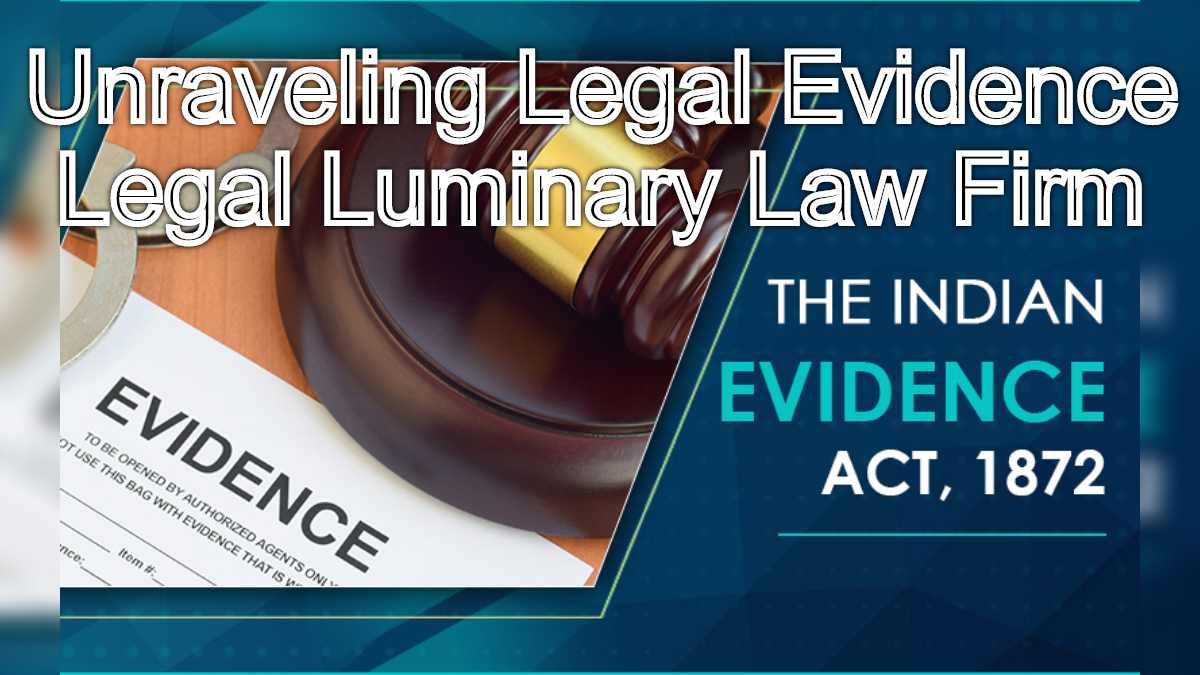Unraveling Legal Evidence: Understanding the Indian Evidence Act, 1872
The Indian legal system hinges on the concept of evidence. Facts presented in court, meticulously gathered and presented according to established rules, determine the outcome of a case. The Indian Evidence Act, 1872 (IEA) serves as the cornerstone of this system, outlining the principles of admissibility and the types of evidence that can be presented in court. Here at Legal Luminary Law Firm, a team of accomplished legal professionals, we strive to empower you with a clear understanding of the IEA, ensuring you navigate the courtroom with confidence.
Demystifying the Courtroom: Understanding the Indian Evidence Act, 1872 with Legal Luminary Law Firm
The Indian Evidence Act, 1872: A Foundation for Fair Trials
Enacted in 1872, the IEA established a framework for handling evidence in Indian courts. This act ensures fairness and consistency in legal proceedings by outlining:
- Relevancy: The IEA emphasizes the importance of presenting evidence that is directly connected to the facts at issue in the case. Irrelevant evidence can be misleading and is typically excluded by the court.
- Admissibility: Not all relevant evidence is automatically admissible. The IEA outlines specific rules regarding the form and manner in which evidence can be presented. For instance, hearsay evidence (second-hand information) is generally inadmissible unless certain exceptions apply.
- Weight of Evidence: The IEA doesn’t assign a specific weight to different types of evidence. The court evaluates the credibility and reliability of each piece of evidence, ultimately determining its persuasive value in reaching a verdict.
Understanding Different Types of Evidence: A Glimpse into the Toolkit
The IEA categorizes evidence into various forms, each playing a crucial role in building a strong case:
- Oral Evidence: Testimonies from witnesses who provide firsthand accounts of events relevant to the case are considered oral evidence. Their credibility and the manner in which they present their testimony significantly impact the weight the court assigns to their statements.
- Documentary Evidence: To be admitted as evidence in court, written documents like contracts, receipts, emails, and official records require proper authentication to ensure their genuineness.
- Circumstantial Evidence: When a court uses established facts to reason out the likely occurrence of another fact, that indirect evidence is called circumstantial evidence. While not conclusive on its own, a strong chain of circumstantial evidence can be highly persuasive.
Legal Luminary Law Firm: Your Trusted Guide Through the Labyrinth of Evidence
Legal Luminary Law Firm recognizes the complexities of navigating the Indian Evidence Act. To ensure your case receives the strongest possible presentation, our seasoned attorneys will equip you with comprehensive legal services:
- Understanding the Legal Landscape: We will meticulously analyze the specific requirements of the IEA as they apply to your case, ensuring all evidence presented adheres to legal guidelines.
- Evidence Gathering and Analysis: Our team will work diligently to gather relevant and admissible evidence, meticulously examining documents, witness testimonies, and other forms of proof to build a strong foundation for your case.
- Presentation in Court: Our lawyers possess the skills and experience to effectively present evidence in court, highlighting its relevance and persuasiveness to strengthen your position.
Demystifying the Law: Addressing Common Questions
Q: What happens if I present inadmissible evidence?
A: The opposing party’s lawyer can object to inadmissible evidence, and the court might exclude it from consideration. Presenting inadmissible evidence can significantly undermine your case. Therefore, a thorough understanding of the rules of evidence is essential.
Q: How do I ensure the credibility of my witnesses?
A: Legal Luminary Law Firm can guide you through preparing your witnesses for testimony. This includes ensuring their understanding of the case and practicing their delivery to enhance their credibility in court.
Q: What if I have only circumstantial evidence?
A: Although circumstantial evidence may not guarantee a conviction on its own, a skilled lawyer can leverage it to build a powerful case. Through meticulous analysis, they can connect the pieces of evidence, crafting a compelling narrative that utilizes all available facts.
Conclusion: Empowering You with Knowledge
Understanding the Indian Evidence Act empowers you to actively participate in the legal process. Legal Luminary Law Firm stands by your side, offering the legal expertise and guidance you need to navigate the complexities of evidence presentation. With our unwavering support, you can present a compelling case and pursue a just outcome.
Contact Legal Luminary Law Firm Today
Schedule a consultation with Legal Luminary Law Firm today. Our dedicated team is here to answer your questions, address your concerns, and ensure you approach the courtroom with clarity and confidence.
Read More
- Celebrating the Significance of the Specific Relief Act, 1963: Key Provisions and Legal Insights
- NCB Officers Must Follow “Toofan Singh” Judgement on Confessional Statements: Supreme Court Reiterates
- Code of Criminal Procedure (CrPC) | Legal Luminary: Law Firm | Top Vakils in Chennai
- Navigating Legal Waters: Expertise in Indian Contract Act, 1872
- NCB Officers Must Follow “Toofan Singh” Judgement on Confessional Statements: Supreme Court Reiterates
- Ministry of Law and Justice:

